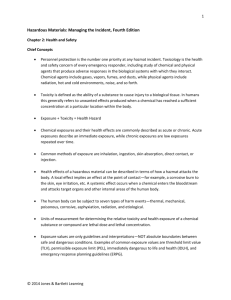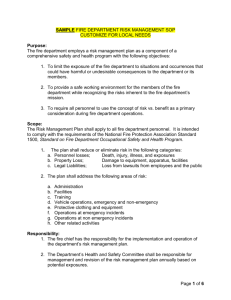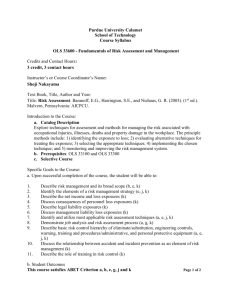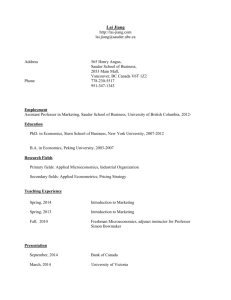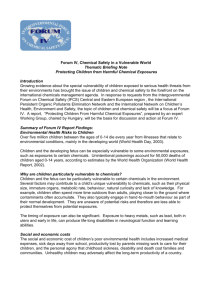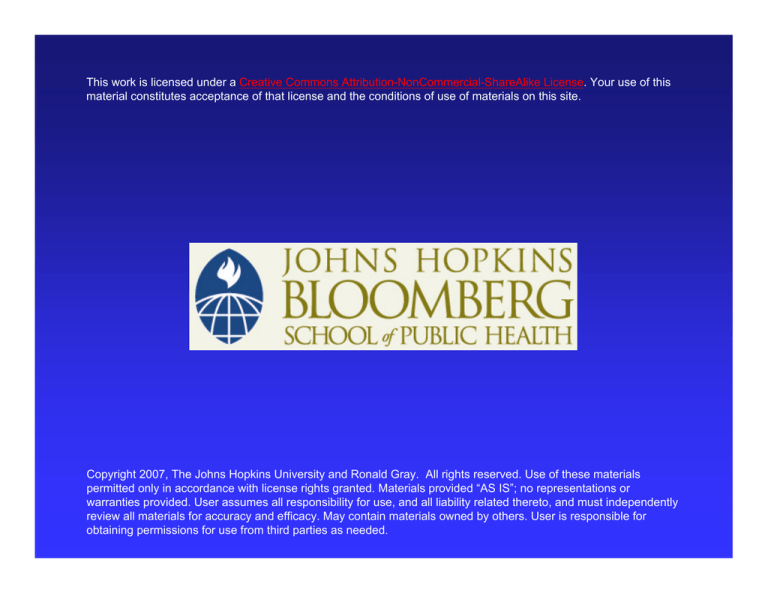
This work is licensed under a Creative Commons Attribution-NonCommercial-ShareAlike License. Your use of this
material constitutes acceptance of that license and the conditions of use of materials on this site.
Copyright 2007, The Johns Hopkins University and Ronald Gray. All rights reserved. Use of these materials
permitted only in accordance with license rights granted. Materials provided “AS IS”; no representations or
warranties provided. User assumes all responsibility for use, and all liability related thereto, and must independently
review all materials for accuracy and efficacy. May contain materials owned by others. User is responsible for
obtaining permissions for use from third parties as needed.
Occupation and
Reproductive Hazards
Reproductive Hazards and
Occupational Exposures
•
•
•
•
•
•
•
•
•
•
Maternal or paternal occupational exposures can affect
reproduction, pregnancy outcome and infant health.
Potential hazards:
chemicals,
physical agents (eg. radiation, lifting, heat),
psychosocial (stress)
Exposures
Total number of persons with potential exposure is substantial,
but numbers with specific exposures are often low due to small
numbers of workers in high risk jobs
Multiple exposures are common and complicate identification of
hazards
Animal toxicology studies have limited utility for predicting
human reproductive hazards
Epidemiologic studies have serious limitations in establishing
causality
Endpoints and Expected Frequencies
•
•
•
•
•
•
•
Subfertility/Infertility (~ 9-10%)
Early Pregnancy Loss (hCG detected ~ 23%)
Spontaneous abortion (~ 10-15%)
Stillbirth (~ 2%)
Prematurity (~ 6-9%)
Low Birthweight (5-7%)
Major defects at birth (~ 3-4%)
• Hard to study in small populations due to lack
of power
Healthy/Unhealthy Worker Effects
• Selection effects (“healthy/unhealthy”) worker
effects
– healthy workers may leave the workplace because
of normal pregnancy /childbearing, causing overrepresentation of “unhealthy” workers
– “Unhealthy” workers may leave job due to illness
– Need to study voluntary terminated ex-employees
of persons on leave of absence
– Difficult to study long-term exposures due to
selection
Employment during pregnancy
• Effects of work in Pregnancy and PTD
– Studies contradictory
– Selection: “unhealthy/healthy worker effect”
Socioeconomic benefits of employment
– Most associations are with prolonged
standing, heavy lifting, long working hours,
shift work, work with industrial machines
Reconstructing Occupational Exposures
•
Job history is difficult
– Recall of jobs or chemicals poor (process information)
– Job titles are non-specific (eg. lab technician)
– Processes change over time
– Timing of exposure relative to reproductive effects may be
problematic (eg. subfertility), timing of exposure in relation to
pregnacy
– Hard to categorize jobs (job title, task analysis,
processes) need to be linked to specific agents
(Industrial Hygiene)
• Exposure assessment
– Dose, duration and timing of exposures
– Route of exposure (inhalation, dermal, ingestion)
– Threshold effects (problem with quantifying
exposure)
Regulation of exposures
• Regulatory:
– Define “Threshold Limit Value” (TLV)
lowest level of permitted exposure
– NIOSH (National Inst Occupational Safety
and Health) recommend TLVs
– Legal and commercial factors affect TLV
– OSHA (Occupational Safety and Health)
regulates TLVs
Epidemiologic Study Designs
• Retrospective Cohort or Case-control studies
– Problems of exposure/outcome timing
– Recall of occupation and specificity of exposures poor
– Job titles (nonspecific), processes, chemical/physical
agents
– Event frequency low (eg. specific birth defects)
– Need medical record validation
– Pregnancy outcome studies exclude infertility effects
• Prospective Studies
– Recognized waiting time to conception/pregnancy loss
(sample size, cost). Allow concurrent exposure
assessment
– Use of hCG to detect early losses or hormonal
disturbances using daily urine samples. Sample size, cost,
compliance
Evidence of Occupational Hazards
•
•
•
•
•
•
•
•
Solvents
Anticancer drugs
Anesthetics
Pesticides
Herbicides
Heavy metals
Radiation
Physical stressors
Fertility and Male Exposures
• Belgian studies of men in smelters and
battery manufacturing, using biologic
measurement of exposure (Gennant 1992)
– Male fertility reduced with
• High level cadmium
• Lead at all levels
• Ethylene glycol ether metabolites in urine
associated with infertility OR 3.1(Veulemans
1993)
• DBCP Fungicide caused testicular atrophy
• Heat (outdoor work, lack of air conditioning)
reduced fertility
Fertility and Female Exposures
• Health Care Workers
• Dental assistants exposed to nitrous oxide
– Reduced fertility increased pregnancy loss
(Rowland NEJM 1992)
• Anesthetics gases increase spontaneous
abortion (RR = 1.5) Figa-Talamanca Epi
Reviews;2000.
• Antineoplastic drugs increase spont abort,
birth defects, menstrual dysfunction
• Microwave exposures increase SABs (QuelletHellstrom Am J Edpid 1993)
Work Stress
• Some association of night work or shift
work with SABs
• High stress vs low stress jobs in nurses
(Hatch Scand J Work Environ Hlth 1999;25:144)
– Long cycles OR = 4.3
– Anovulation OR = 5.5
• Heavy lifting increase SABs (OR = 3.2. Florack
Epidemiol 1993)
Solvents
• Microchip manufacturing
– reduced fertility
– increased spontaneous abortion
– mainly in subgroups working with solvents
such as short chain ethylene glycol ethers
(EGEs)
Short Chain Ethylene Glycol Ethers
(EGE)
• Were widely used (microchips, paint, printing,
electronics)
• Low volatility (most exposure is dermal)
• Penetrate most rubber gloves
• Animal studies show reproductive and
teratogeneic effects
• Biological mechanism: Metabolized to alkoxy
acetic acid which prevents DNA synthesis
during cell division, detectable in urine
(biomarker)
Three studies of Female EGE Exposures
in Microchip manufacturing
• EGEs used in manufacture of microchips
• Spontaneous abortions
– OR 2.4 (Pastides, 1988)
– OR 2.8 (Gray 1996)
– OR 2.3 (Swann, 1996)
• Subfertility
– OR 4.6 (Gray 1996)
Cardiac Defects and Solvents
(Baltimore Washington Study, Ferencz 1993)
• Population based case-control study
• Type of exposure and type of defect varied
• Aortic stenosis
– Any solvent
OR = 3.2
– Degreasing solvents OR = 12.5
• Coarctation of the aorta
– Any solvent
OR = 3.4
– Degreasing solvents OR = 3.0
• Specific defects may result from highly
specific exposures or from generalized
exposures to a family of agents
Pesticide Exposures in Agriculture
• Malformations
– Several organ
systems (Nurminen,
1995)
• Spontaneous Abortion
– Female agricultural
workers, different
exposures, seasonal.
(Nurminen, 1995)
• Stillbirths
– Agricultural workers
in Sudan (Taha
Gray)
• Subfertility
• Female
– Agricultural workers,
manufacturing
• Male
– DBCP (testicular
damage)
DDT and Reproduction
• Measure DDE (metabolite of DDT) in
serum (Longnecker Lancet 2001;358:110)
– PTD: Adjusted OR increased from 1.8 to
4.0 with DDE 15-29 ug/L to >60 ug/L
(p<0.0001).
– SGA: Adjusted OR increased 1.9 to 2.6
with increasing DDE (p = 0.04)
Sex ratio and exposures
• Seveso, Italy 1976. Explosion in
herbicide plant released dioxin (Mocarelli
Lancet 2000)
– Men under 19 exposed at time of explosion
subsequently fathered more girls than boys
– sex ratio m/f = 0.38 CI 0.3-0.47
– No effects in exposed females
Sex ratio and PCB exposure Taiwan
• PCB exposure via contaminated cooking oil
• Males <19, Sex ratio m/f = 0.85 (p = 0.04)
• Males >19 and females no effect
– Similar effects observed in rats
– Mechanism??
•
Del Rio Lancet 2002;360:143
• Also observed oligospermia, abnormal sperm
morphology and inability to penetrate oocyte
in vitro (Huang JAMA 2003;289:2943)
Accidental Exposures
• Highest dose exposures often related to
accidents
– Spills
– Explosions
– Contamination of food and water
– Hard to document
Health Protection
• Exclude from “high risk” jobs
• Move pregnant women to low risk jobs
• Problems:
– Identify hazards (problematic); what is low risk
– Identify limits of exposure Threshold limit value
(TLV), known for < 13% of potential hazards
– Protection of “average worker” versus vulnerable
subgroups
– “Cautionary principle” (UN 1992), suspicion is
sufficient, lack of scientific “certainty” should
not be used to perpetuate exposures
– Economic costs, limitation of women’s choices?



